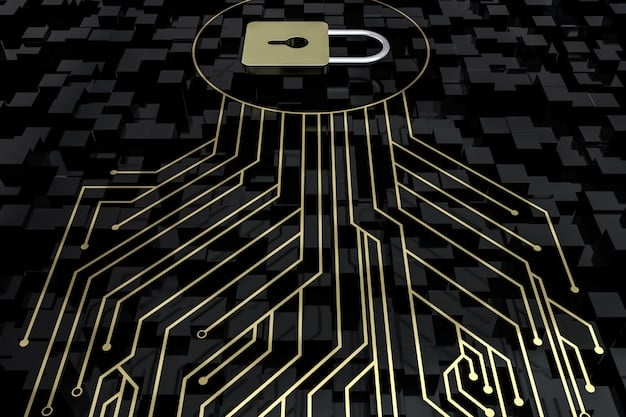Award Show Security 2025: New Tech & Protocols for Safe Events

Anúncios
Award Show Security: New Protocols and Technologies for 2025 will leverage AI-powered surveillance, advanced access control, and enhanced cybersecurity measures to protect attendees and ensure seamless event execution.
The glitz and glamour of award shows are undeniable. However, behind the red carpets and flashing cameras lies a complex web of security measures. As we look towards 2025, award show security: new protocols and technologies for 2025 are evolving rapidly to address emerging threats and ensure the safety of attendees and performers.
Anúncios
The Evolving Landscape of Award Show Security
Award show security is no longer just about traditional barricades and security guards. The threat landscape is constantly changing, and security professionals must adapt to protect against a wide range of potential risks. New technologies and protocols are being developed to address these challenges and ensure the safety of everyone involved.
From cybersecurity threats to physical security breaches, award shows face a unique set of challenges. Understanding these risks and implementing effective countermeasures is crucial for maintaining a secure and enjoyable event. Let’s dive into the evolving landscape and explore the key areas of focus.
Anúncios
Understanding Current Security Challenges
Modern award shows present a complex security environment, facing threats from various sources. Crowd management, cybersecurity, and potential for targeted attacks require comprehensive security solutions.
The Role of Technology in Modern Security
Technology is playing an increasingly important role in award show security. From advanced surveillance systems to AI-powered threat detection, technology is helping security professionals stay one step ahead of potential threats.
- Advanced Surveillance: Use of high-resolution cameras and drones for comprehensive monitoring.
- AI-Powered Threat Detection: Real-time analysis of data to identify and respond to potential threats.
- Cybersecurity Measures: Protection against hacking and data breaches.
- Access Control Systems: Secure entry and exit points with biometric and RFID technology.
The integration of these technologies enhances the overall security posture, allowing for quicker response times and more effective threat mitigation.
Advancements in Access Control Systems
One of the most critical aspects of award show security is controlling access to the venue. Traditional methods like ticket scanning and visual identification are no longer sufficient to meet the demands of modern security. Advancements in access control systems are providing enhanced security and streamlined entry processes.
Biometric scanning, RFID technology, and integrated databases are revolutionizing the way award shows manage access. These technologies provide a more secure and efficient way to verify identities and prevent unauthorized entry.

Biometric Scanning Technologies
Biometric scanning technologies like facial recognition and fingerprint scanning are being used to verify the identity of attendees and staff. These technologies offer a high level of accuracy and security, making it difficult for unauthorized individuals to gain access.
RFID Technology and Smart Ticketing
RFID technology and smart ticketing systems provide a more efficient and secure way to manage entry. These systems allow for quick verification of tickets and can be integrated with databases to track attendance and identify potential security risks.
- Enhanced Security: Prevents fraudulent tickets and unauthorized entry.
- Efficient Entry: Streamlines the entry process, reducing wait times.
- Real-Time Tracking: Provides real-time data on attendance and venue occupancy.
By implementing these advanced access control systems, award shows can significantly enhance their security posture and provide a safer environment for attendees.
AI-Powered Surveillance and Threat Detection
Artificial intelligence (AI) is transforming the way award shows approach surveillance and threat detection. AI-powered systems can analyze vast amounts of data in real-time, identifying potential threats and alerting security personnel to suspicious activity. This proactive approach to security is helping to prevent incidents before they occur.
Facial recognition, behavior analysis, and anomaly detection are just a few of the ways AI is being used to enhance award show security. These technologies provide a more comprehensive and effective way to monitor the venue and respond to potential threats.
Facial Recognition Technology
Facial recognition technology can identify individuals on watchlists and alert security personnel to their presence. This technology is particularly useful for preventing known offenders from entering the venue.
Behavior Analysis and Anomaly Detection
Behavior analysis and anomaly detection systems can identify suspicious behavior patterns and alert security personnel to potential threats. These systems can detect unusual movements, unattended packages, and other indicators of potential risk.
- Real-Time Threat Detection: Identifies potential threats in real-time.
- Proactive Security: Prevents incidents before they occur.
- Enhanced Monitoring: Provides a more comprehensive view of the venue.
The application of AI in surveillance and threat detection offers a significant advantage, enabling security teams to maintain a higher level of vigilance and responsiveness.
Cybersecurity Measures for Award Shows
In today’s digital age, cybersecurity is a critical component of award show security. Award shows are vulnerable to a wide range of cyber threats, including hacking, data breaches, and denial-of-service attacks. Implementing robust cybersecurity measures is essential for protecting sensitive information and ensuring the smooth operation of the event.
Protecting ticketing systems, securing data networks, and preventing cyberattacks are key priorities for award show security professionals. By taking a proactive approach to cybersecurity, award shows can minimize their risk and protect themselves from potential cyber threats.

Protecting Ticketing Systems from Fraud
Ticketing systems are a prime target for cybercriminals. Implementing robust security measures, such as encryption and multi-factor authentication, is crucial for protecting ticketing systems from fraud and unauthorized access.
Securing Data Networks and Communications
Data networks and communication systems must be secured to prevent data breaches and eavesdropping. Encryption, firewalls, and intrusion detection systems are essential for protecting sensitive information.
- Data Encryption: Protects sensitive information from unauthorized access.
- Firewalls: Prevents unauthorized access to networks.
- Intrusion Detection Systems: Detects and responds to cyberattacks.
By strengthening cybersecurity defenses, award shows can safeguard their data and maintain the integrity of their operations.
Enhanced Crowd Management Strategies
Effective crowd management is essential for ensuring the safety and security of award show attendees. Large crowds can present significant challenges, and security professionals must implement strategies to manage crowd flow, prevent overcrowding, and respond to emergencies. Enhanced crowd management strategies are helping to create a safer and more enjoyable experience for everyone.
Using technology to monitor crowd density, implementing clear communication channels, and training staff to respond to emergencies are key components of effective crowd management. By taking a proactive approach to crowd management, award shows can minimize the risk of incidents and ensure the safety of attendees.
Using Technology to Monitor Crowd Density
Technology can be used to monitor crowd density in real-time, allowing security personnel to identify and address potential overcrowding issues. This technology can help to prevent dangerous situations and ensure the safety of attendees.
Implementing Clear Communication Channels
Clear communication channels are essential for informing attendees about important information and providing instructions in the event of an emergency. Public address systems, mobile apps, and social media can be used to communicate with attendees and keep them informed.
- Real-Time Monitoring: Provides up-to-date information on crowd density.
- Effective Communication: Keeps attendees informed and provides instructions.
- Emergency Response: Facilitates quick and coordinated responses to emergencies.
By prioritizing effective crowd management, award shows can create a safer and more organized environment for all participants.
Collaboration and Information Sharing
Collaboration and information sharing are critical for effective award show security. Security professionals must work together with law enforcement, event organizers, and other stakeholders to share information and coordinate security efforts. This collaborative approach helps to ensure that all potential threats are addressed and that security measures are implemented effectively.
Establishing clear communication channels, conducting joint training exercises, and sharing intelligence are key components of effective collaboration. By working together, security professionals can enhance their ability to protect award shows from potential threats.
Establishing Clear Communication Channels
Establishing clear communication channels is essential for sharing information and coordinating security efforts. This includes establishing protocols for communication between security personnel, law enforcement, and event organizers.
Conducting Joint Training Exercises
Joint training exercises can help to ensure that security personnel are prepared to respond to a variety of potential threats. These exercises can simulate real-world scenarios and provide valuable training opportunities.
- Improved Coordination: Enhances communication and coordination between stakeholders.
- Enhanced Preparedness: Ensures that security personnel are prepared to respond to threats.
- Effective Information Sharing: Facilitates the sharing of intelligence and threat information.
Through robust collaboration and information sharing, award shows can achieve a higher level of security and resilience.
| Key Aspect | Brief Description |
|---|---|
| 🛡️ Access Control | Biometric & RFID tech for secure entry verification. |
| 🤖 AI Surveillance | Real-time threat detection via facial and behavior analysis. |
| 💻 Cybersecurity | Protection of ticketing and data networks from cyber threats. |
| 🚶 Crowd Management | Tech-driven monitoring and emergency response planning. |
Frequently Asked Questions
▼
Major concerns include cyberattacks targeting ticketing and data systems, physical threats from individuals or groups, and managing large crowds efficiently to prevent accidents or security breaches.
▼
AI improves security through real-time threat detection, facial recognition to identify individuals on watchlists, and behavior analysis to spot suspicious activities, allowing quicker responses to potential threats.
▼
Cybersecurity is crucial for protecting sensitive information related to ticketing and attendee data, preventing fraud and unauthorized access, and ensuring uninterrupted communications and operations during the event.
▼
Biometric access control, such as facial recognition and fingerprint scanning, provides a higher level of security by accurately verifying attendee and staff identities, reducing the risk of unauthorized entry and fraudulent activity.
▼
Award shows are enhancing emergency preparedness by implementing clear communication channels, providing staff training for incident response, and using technology to monitor crowd density and coordinate responses effectively during critical situations.
Conclusion
As we move closer to 2025, the focus on enhancing security measures at award shows is becoming increasingly critical. By integrating new technologies, improving cybersecurity protocols, and fostering greater collaboration, award shows can provide a safe and enjoyable experience for all attendees. The future of award show security lies in continuous innovation and adaptation to evolving threats.





